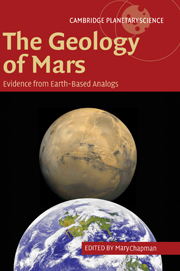Book contents
- Frontmatter
- Contents
- Preface: the rationale for planetary analog studies
- List of contributors
- 1 The geology of Mars: new insights and outstanding questions
- 2 Impact structures on Earth and Mars
- 3 Terrestrial analogs to the calderas of the Tharsis volcanoes on Mars
- 4 Volcanic features of New Mexico analogous to volcanic features on Mars
- 5 Comparison of flood lavas on Earth and Mars
- 6 Rootless volcanic cones in Iceland and on Mars
- 7 Mars interior layered deposits and terrestrial sub-ice volcanoes compared: observations and interpretations of similar geomorphic characteristics
- 8 Lava—sediment interactions on Mars: evidence and consequences
- 9 Eolian dunes and deposits in the western United States as analogs to wind-related features on Mars
- 10 Debris flows in Greenland and on Mars
- 11 Siberian rivers and Martian outflow channels: an analogy
- 12 Formation of valleys and cataclysmic flood channels on Earth and Mars
- 13 Playa environments on Earth: possible analogs for Mars
- 14 Signatures of habitats and life in Earth's high-altitude lakes: clues to Noachian aqueous environments on Mars
- 15 The Canyonlands model for planetary grabens: revised physical basis and implications
- 16 Geochemical analogs and Martian meteorites
- 17 Integrated analog mission design for planetary exploration with humans and robots
- Index
- Plate section
- References
12 - Formation of valleys and cataclysmic flood channels on Earth and Mars
Published online by Cambridge University Press: 18 September 2009
- Frontmatter
- Contents
- Preface: the rationale for planetary analog studies
- List of contributors
- 1 The geology of Mars: new insights and outstanding questions
- 2 Impact structures on Earth and Mars
- 3 Terrestrial analogs to the calderas of the Tharsis volcanoes on Mars
- 4 Volcanic features of New Mexico analogous to volcanic features on Mars
- 5 Comparison of flood lavas on Earth and Mars
- 6 Rootless volcanic cones in Iceland and on Mars
- 7 Mars interior layered deposits and terrestrial sub-ice volcanoes compared: observations and interpretations of similar geomorphic characteristics
- 8 Lava—sediment interactions on Mars: evidence and consequences
- 9 Eolian dunes and deposits in the western United States as analogs to wind-related features on Mars
- 10 Debris flows in Greenland and on Mars
- 11 Siberian rivers and Martian outflow channels: an analogy
- 12 Formation of valleys and cataclysmic flood channels on Earth and Mars
- 13 Playa environments on Earth: possible analogs for Mars
- 14 Signatures of habitats and life in Earth's high-altitude lakes: clues to Noachian aqueous environments on Mars
- 15 The Canyonlands model for planetary grabens: revised physical basis and implications
- 16 Geochemical analogs and Martian meteorites
- 17 Integrated analog mission design for planetary exploration with humans and robots
- Index
- Plate section
- References
Summary
Introduction
The origin of fluvial valleys has been one of the great problems of science ever since the debates in the eighteenth and early nineteenth centuries over the role of cataclysmic events in the shaping of Earth's valleys. The famous founders of geology, including Hutton, Lyell, and Cuvier all participated in these great debates. It can be argued that geology emerged as a science because of the scientific reasoning that was applied to this problem (Davies, 1969).
It was one of the great surprises of modern planetary science that fluvial valleys were discovered on the planet Mars by study of the vidicon images returned by the Mariner 9 spacecraft (Masursky, 1973). From the much more extensive coverage of the Viking mission we know that the heavily cratered Martian highlands are locally dissected by networks of tributary valleys with widths of 10 km or less and lengths of a few kilometers to nearly 1000 km. These valley networks are one major type of large elongate Martian troughs thought to have fluvial origins (Baker, 1982).
In distinction from fluvial valleys, large outflow channels show extensive evidence of large-scale fluid flow on their floors and walls (Baker et al., 1992a), so technically speaking they are channels, rather than valleys. This is a rather curious circumstance, since Earth experience leads us to suppose that fluvial channels are invariably much smaller than fluvial valleys. However, the Martian outflow channels may arise from the peculiar geological history of Mars and its water endowment (Baker et al. 1991).
- Type
- Chapter
- Information
- The Geology of MarsEvidence from Earth-Based Analogs, pp. 297 - 321Publisher: Cambridge University PressPrint publication year: 2007
References
- 7
- Cited by

